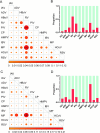Resurgence of common respiratory viruses and mycoplasma pneumoniae after ending the zero-COVID policy in Shanghai
- PMID: 39800785
- PMCID: PMC11725580
- DOI: 10.1038/s41598-025-85852-z
Resurgence of common respiratory viruses and mycoplasma pneumoniae after ending the zero-COVID policy in Shanghai
Abstract
China has adhered to policies of zero-COVID for almost three years since the outbreak of COVID-19, which has remarkably affected the circulation of respiratory pathogens. However, China has begun to end the zero-COVID policies in late 2022. Here, we reported a resurgence of common respiratory viruses and Mycoplasma pneumoniae with unique epidemiological characteristics among children after ending the zero-COVID policy in Shanghai, China, 2023. Children hospitalized with acute respiratory tract infections were enrolled from January 2022 to December 2023. Nine common respiratory viruses and 2 atypical bacteria were detected in respiratory specimens from the enrolled patients using a multiplex PCR-based assay. The data were analyzed and compared between the periods before (2022) and after (2023) ending the zero-COVID policies. A total of 8550 patients were enrolled, including 6170 patients in 2023 and 2380 patients in 2022. Rhinovirus (14.2%) was the dominant pathogen in 2022, however, Mycoplasma pneumoniae (38.8%) was the dominant pathogen in 2023. Compared with 2022, the detection rates of pathogens were significantly increased in 2023 (72.9% vs. 41.8%, p < 0.001). An out-of-season epidemic of respiratory syncytial virus was observed during the spring and summer of 2023. The median age of children infected with respiratory viruses in 2023 was significantly greater than that in 2022. Besides, mixed infections were more frequent in 2023 (23.8% vs. 28.9%, p < 0.001). China is now facing multiple respiratory pathogen epidemics with changing seasonality, altered age distribution, and increasing mixed infection rates among children in 2023. Our finding highlights the need for public health interventions to prepare for the respiratory pathogen outbreaks in the post-COVID-19 era.
Keywords: COVID-19; Children; NPIs; Prevalence; Respiratory pathogens.
© 2025. The Author(s).
Conflict of interest statement
Declarations. Competing interests: The authors declare no competing interests. Ethics approval and consent to participate: Approval to conduct this study was granted by the Medical Research Ethics Committee of the Children’s Hospital of Fudan University. This study was a retrospective study, and the use of anonymized information data for research complied with relevant regulations and ethical principles. Informed consent was waived by the Medical Research Ethics Committee of the Children’s Hospital of Fudan University.
Figures



Similar articles
-
Analysis of respiratory pathogen detection in hospitalized children with acute respiratory tract infections after ending the zero COVID policy.Sci Rep. 2024 Dec 30;14(1):31784. doi: 10.1038/s41598-024-82660-9. Sci Rep. 2024. PMID: 39738485 Free PMC article.
-
Mycoplasma pneumoniae detections in children with lower respiratory infection before and during the COVID-19 pandemic: a large sample study in China from 2019 to 2022.BMC Infect Dis. 2024 Jun 1;24(1):549. doi: 10.1186/s12879-024-09438-2. BMC Infect Dis. 2024. PMID: 38824572 Free PMC article.
-
[Analysis of pathogen distribution and epidemiology of acute lower respiratory tract infections in children from 2019-2023].Zhonghua Liu Xing Bing Xue Za Zhi. 2025 Jun 10;46(6):1036-1042. doi: 10.3760/cma.j.cn112338-20250111-00029. Zhonghua Liu Xing Bing Xue Za Zhi. 2025. PMID: 40518399 Chinese.
-
Impact of COVID-19 pandemic measures on hospitalizations and epidemiological patterns of twelve respiratory pathogens in children with acute respiratory infections in southern China.BMC Infect Dis. 2025 Jan 22;25(1):103. doi: 10.1186/s12879-025-10463-y. BMC Infect Dis. 2025. PMID: 39844061 Free PMC article.
-
Synergistic impact of macrolide resistance and H3N2 infection on M. pneumoniae outbreak in children.Microbiol Spectr. 2025 Apr;13(4):e0184424. doi: 10.1128/spectrum.01844-24. Epub 2025 Feb 25. Microbiol Spectr. 2025. PMID: 39998323 Free PMC article.
Cited by
-
Epidemiological association of the COVID-19 pandemic on Mycoplasma pneumoniae infections in children in Tianjin, China: a single-centre retrospective study (2017-2024).BMJ Open. 2025 Jun 17;15(6):e101045. doi: 10.1136/bmjopen-2025-101045. BMJ Open. 2025. PMID: 40527576 Free PMC article.
-
Clinical characteristics of single human rhinovirus infection and co-infection in the respiratory tract of children.Transl Pediatr. 2025 Mar 31;14(3):373-381. doi: 10.21037/tp-24-79. Epub 2025 Mar 26. Transl Pediatr. 2025. PMID: 40225074 Free PMC article.
-
Asthma control after recovery from mild to moderate COVID-19: from Omicron BA.2 to XBB- from a cohort in a university hospital in Hong Kong.BMC Pulm Med. 2025 Feb 11;25(1):74. doi: 10.1186/s12890-025-03543-x. BMC Pulm Med. 2025. PMID: 39934807 Free PMC article.
-
A comparison of diagnostic and therapeutic approaches for Mycoplasma pneumoniae pneumonia in children and adults, during the post-COVID-19 pandemic era.Eur J Clin Microbiol Infect Dis. 2025 Jul;44(7):1677-1694. doi: 10.1007/s10096-025-05142-4. Epub 2025 Apr 29. Eur J Clin Microbiol Infect Dis. 2025. PMID: 40299295
References
Publication types
MeSH terms
Grants and funding
LinkOut - more resources
Full Text Sources
Medical

